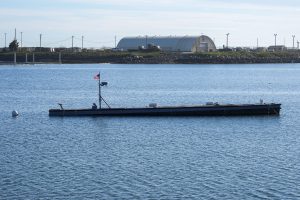The United States Marine Corps has deployed an unmanned semi-submersible vessel at the U.S military’s port facility on the main island of Okinawa Prefecture, Japan.
This is the first time the U.S. Marine Corps has deployed an autonomous watercraft in Japan.
On October 10, the Okinawa Defense Bureau, a branch office of Japan’s Ministry of Defense, informed Okinawa Prefecture and Okinawa City that the U.S. Marine Corps had deployed its Autonomous Low-Profile Vessel (ALPV), a new unmanned supply vessel under development, at the U.S. military’s Naha Port Facility on Okinawa Island on October 9, according to officials in Okinawa Prefecture and Okinawa City.
The ALPV has a standard displacement of about 8.3 tons, an overall length of about 19 meters, and a beam of 2.5 meters, according to the Okinawa Defense Bureau documents, which were obtained by The Diplomat.
For the next 11 months – from this month until August next year – the vessel will be mainly based at the Naha military port. It will also be used at the west coast area of Ie Jima Auxiliary Airfield, Red Beach in Kin Town, and White Beach Naval Facility, the documents show.
The U.S. military newspaper Stars and Stripes reported on October 7 that various units of III Marine Expeditionary Force will use the vessel during its time on Okinawa, citing a spokesman for the III MEF. The only expeditionary force to be headquartered outside the United States, the III MEF has its headquarters at Camp Courtney located in Uruma City, Okinawa.
Japan’s new Defense Minister Nakatani Gen said at a press conference on October 8 that the deployment of the new boat involves replenishment activities such as transporting supplies to troops in the coastal waters around Okinawa Island. The ALPV is also conducting various evaluation tests, Nakatani said, citing the explanation from the U.S. side.
“The purpose is to strengthen the logistical support functions of the U.S. military. Therefore, we recognize that this will contribute to further strengthening the deterrence and response capabilities of the Japan-U.S. alliance,” the defense minister stressed.
The vessel will be used to transport supplies such as food, and there are currently no plans for the ALPV to transport missiles or ammunition, according to the Okinawa Defense Bureau. The U.S. military has explained that it will ensure safety by having manned safety boats accompany the unmanned vessel.
In light of the ALPV deployment, a spokesperson at the Military Base Affairs Division of Okinawa Prefecture told The Diplomat on October 10, “There must be no new increase in the burden of the U.S. bases in Okinawa. We will continue to gather information and call for a reduction in the burden of the bases.”
The ALPV is a semi-submersible unmanned platform. According to U.S. media, Brig. Gen. Simon Doran, commander of the Marine Corps Warfighting Laboratory in Quantico, Virginia, suggested at a conference on September 4 that the system resembles low-profile boats used by drug traffickers in Latin America.
“Truth be told, this is just a narco boat. You know, we stole the idea from friends down south,” Doran reportedly joked. “And so this is, you know, 55-feet long, completely autonomous. It’s able to go hundreds or thousands of miles. It’s able to carry weapon systems that we have that are new. It can carry fuel. It can carry food. It can carry pretty much anything you want to put in it.”
With a more assertive China in mind, the U.S. Marine Corps has adopted the Expeditionary Advanced Base Operations (EABO) concept. This form of warfare involves rapidly deploying small units to remote islands to prepare frontline bases. To do so, rear support activities – such as supplying supplies using unmanned boats – are becoming necessary.
In November 2023, the U.S. Marine Corps reorganized the 12th Marine Regiment into the 12th Marine Littoral Regiment (MLR) on November 15, 2023 at Camp Hansen in Okinawa. The MLR will be able to respond immediately to remote island emergencies. In addition to the littoral combat unit, air defense unit, and rear support unit responsible for supply and maintenance, the MLR plans to add an unmanned boat unit that will combine intelligence gathering and attack capabilities in the future.
For this reason, the deployment of the ALPV in Okinawa this time may be a stepping stone to the future.

































